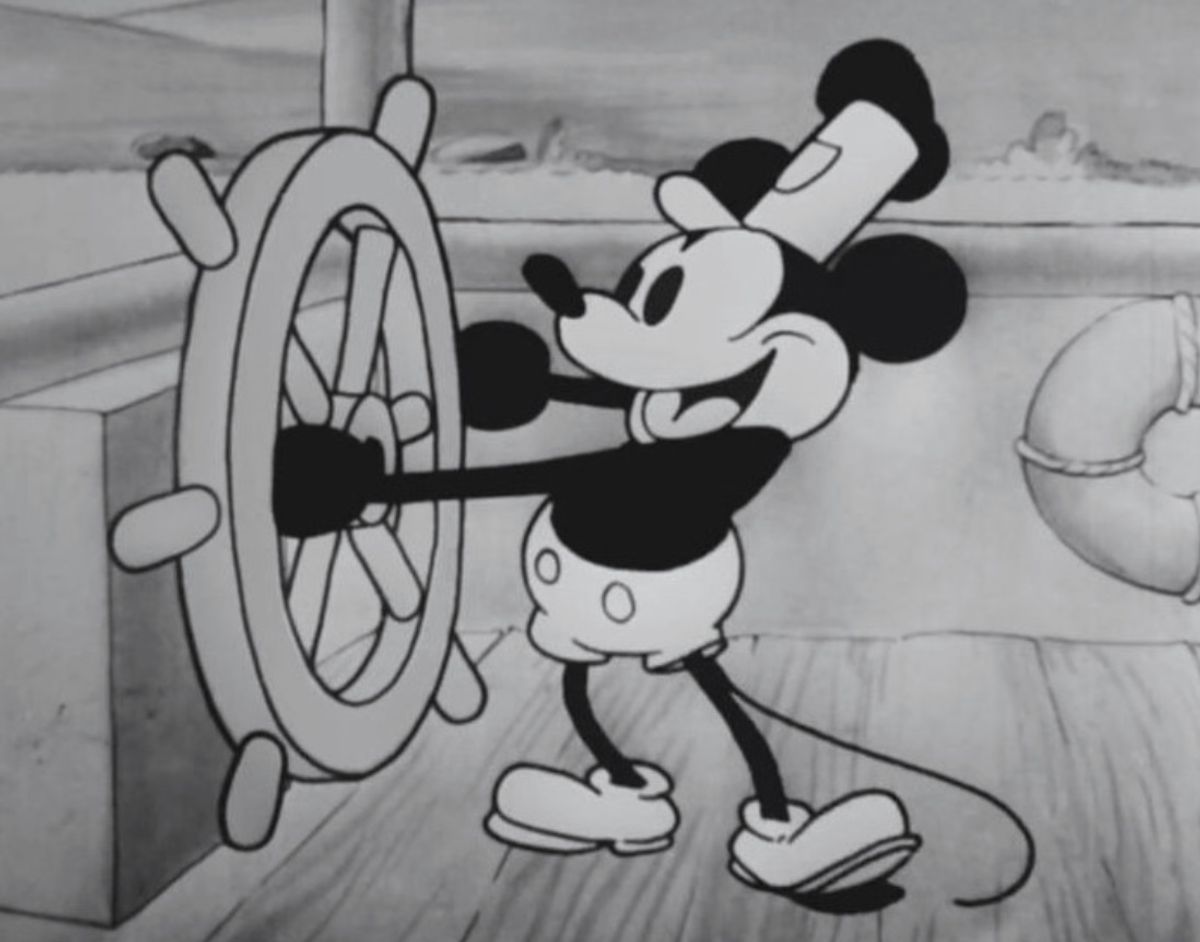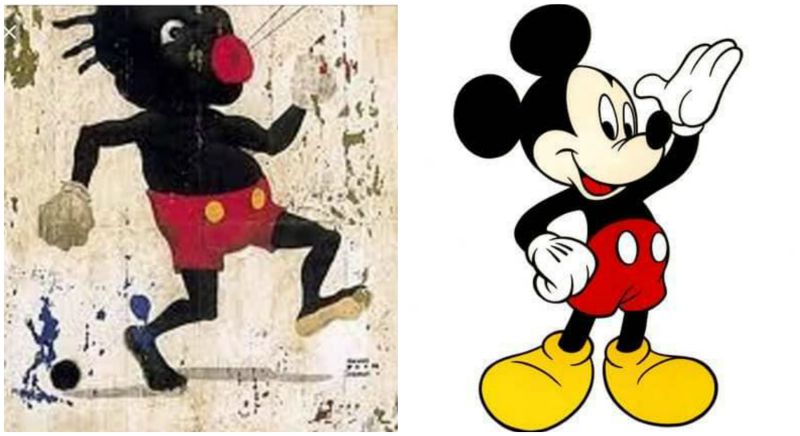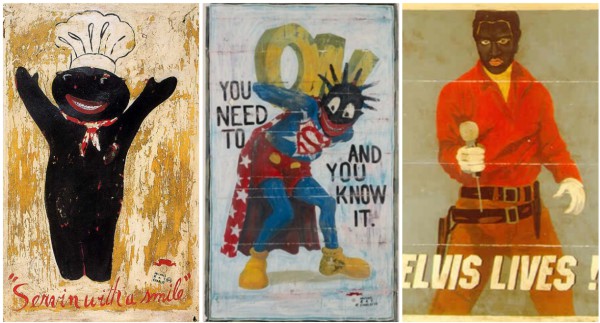In February 2019, an image showing "Jigaboo," a racist caricature that supposedly served as the inspiration for Disney's Mickey Mouse character, began to spread via social media:
The most popular posting of these images that we could find was accompanied by a caption stating: "RACISM ... Mickey mouse was a remake of a character named jigaboo who was made to mock black people ... And I use to like Mickey Mouse smh ??♂️"
This caricature was not the inspiration for Mickey Mouse, nor did it depict an early cartoon character known as "Jigaboo." This image is a contemporary work of art by Michael Ray Charles that was created in 1994 (nearly 70 years after Mickey Mouse made his first appearance in 1928) entitled "(Forever Free) BEWARE."
The fact that the character in "BEWARE" resembles Mickey Mouse, however, is not a coincidence. Charles also created several other artworks which overlaid racial stereotypes onto modern characters and symbols such as the Pillsbury Dough Boy, Superman, and Elvis Presley:
Art critic Rebecca Cohen explored Charles' work in a 1997 article published in the Austin Chronicle:
They are about the negative stereotypes that African-Americans still buy into -- the minstrel and the mammy -- and how they update them, hide behind them. They are about the racial stereotypes that white people created and perpetuate still, rather than acknowledging African-Americans as complex and individual human beings. Charles says that negative images about African-Americans are hiding throughout American culture, just below the surface, on TV sitcoms and cartoons of every vintage and in advertising and sports. He didn't invent them, he is not singlehandedly perpetuating them. His paintings seek to create understanding rather than foster blame. They are about deconstructing symbols and tracing their history, past to present ...
Michael Ray Charles contends that you have to open up old stereotypes and lay them out, superimpose them on top of today's world, in order to understand them, to have any chance at all of truly making them go away. "The past is present," he says with each new painting. Burning all the books about Sambo and tossing Aunt Jemima into history's trash heap isn't going to make them disappear. Charles paints Aunt Jemima wearing a Wonder Woman costume or standing in a sexy pose like Marilyn Monroe with the wind whooshing up her skirt, only wearing floppy pink slippers on her feet and a red and white polka-dot kerchief tied on her head. His Michael Jackson wears a jester's cap with little Sambo faces at each point instead of bells. In Charles' Liberty Bros. Permanent Daily Circus posters, figures named Dawg Boy and Sealboy perform for the crowd. In Charles' puzzle painting Join the Club, three little Sambos feast on basketballs with a juicy red filling that looks suspiciously like watermelon. The painting reads: Join the Club. You'll have a ball. A piece of the puzzle is missing.
Artist Michael Owen added more insight into Charles' work:
“Stereotypes have evolved,” he notes. “I’m trying to deal with present and past stereotypes in the context of today’s society.” Twisted caricatures of African-American experience, such as Aunt Jemima, are represented in Charles’s work as ordinary depictions of blackness, yet are stripped of the aura of harmlessness that lends them an appearance of truth that is very seldom questioned. People just don’t stop to think about where these images come from.
Charles says, “Aunt Jemima is just an image, but it almost automatically becomes a real person for many people, in their minds. But there’s a difference between these images and real humans.” In each of his paintings, notions of beauty, ugliness, nostalgia, and violence emerge and converge, reminding us that we can’t easily divorce ourselves from a past that has led us to where we are, who we have become, and how we are portrayed.
While this viral image does not depict a character named "Jigaboo" which served as the inspiration for Mickey Mouse, Charles' painting does invoke the early history of the latter character. Many historians of the period believe that Mickey Mouse, like other early 20th century animated characters, was heavily influenced by blackface performers and minstrel shows of the time.
A collection of essays entitled A Mickey Mouse Reader includes several mentions of Mickey's supposed minstrel show influences. Here's how M. Thomas Inge described Disney's famous character in his essay "Mickey Mouse":
Like Felix, Bimbo, Oswald, most of the animated film characters who preceded him, Mickey had a black body and head, large white eyeballs, and a white area around the mouth -- all characteristic of African Americans as portrayed stereotypically in cartoons, illustrations, and advertising of the time and based on the image of minstrel show performers in black face. When white gloves were added, Mickey moved even closer to his sources. None of these characters retained, however, any of the language or cultural nuances of black life, although Mickey has sometimes been thought to retain some of the free-swinging style of the hipster and trickster.
Nicholas Sammond argued in his book Birth of an Industry: Blackface Minstrelsy and the Rise of American Animation that Mickey Mouse (and similar animated characters) wasn't just like a minstrel -- the premier Disney character, according to Sammond, was a cartoon minstrel:
American animation, which had its origins and developed many of its enduring conventions on the vaudeville stage, is not merely one more in a succession of textual forms; it is also a performative tradition that is indebted to and imbricated in blackface minstrelsy and vaudeville. Commercial animation in the United States didn't borrow from blackface minstrelsy, nor was it simply influenced by it. Rather, American animation is actually in many of its most enduring incarnations an integral part of the ongoing iconographic and performative traditions of blackface. Mickey Mouse isn't like a minstrel; he is a minstrel.
Either way, a character named "Jigaboo" did not serve as the main inspiration for Mickey Mouse. The "Jigaboo" racial caricature was a modern creation (from 1994) based upon the famous Disney character and his suspected connection to blackface minstrelsy, not the other way around.



